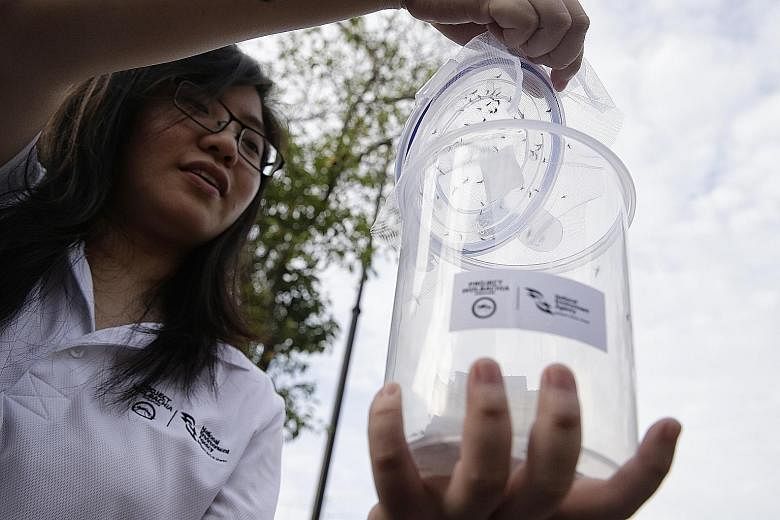The use of male Aedes aegypti mosquitoes carrying the Wolbachia bacteria to control the spread of dengue in a small-scale field study in three areas in Singapore has shown promise, with valuable data for future suppression trials.
After three months of releases at the Tampines West site, the viability of Aedes mosquito eggs collected from the site has been reduced by about half, the National Environment Agency (NEA) said in a media statement yesterday.
This suggests that the released male Wolbachia-Aedes mosquitoes successfully mated with the urban Aedes aegypti females.
Investigations at the other two sites, Braddell Heights and Nee Soon East, focused mainly on understanding the mate-seeking behaviour and flight ability of the released male Wolbachia-Aedes mosquitoes, as well as how well they survive in the urban environment.
Other data gathered include details on how far and high the mosquitoes fly and how long they live.
Conclusions from the data were derived after a three-day meeting between NEA's Dengue Expert Advisory Panel and NEA's Environmental Health Institute.
In October last year, NEA started the field study at Braddell Heights, followed by Tampines West and Nee Soon East a month later.
When male mosquitoes carrying the naturally occurring Wolbachia bacteria mate with female mosquitoes, the bacteria causes the females to produce eggs that do not hatch.
The aim of this is to reduce the Aedes aegypti population, which transmits the viruses that cause dengue fever. These mosquitoes also carry the chikungunya and Zika viruses.
NEA appointed the panel in June 2014 to provide professional advice on the use of Wolbachia for suppression of the Aedes aegypti mosquito population.
The panel comprises experts from Australia, Singapore, Britain and the United States, with specialised knowledge on vector-borne diseases, entomology, epidemiology, virology and public health.
The panel chairman, Professor Duane Gubler, founding director of the Emerging Infectious Diseases Programme at Duke-NUS Medical School, said: "NEA and the people of Singapore are to be congratulated on the rapid containment of what could have been a major Zika epidemic here."
More data is being collected from the field study to refine the suppression trial design.
NEA, in its release, said the Wolbachia-Aedes technology is promising, but is not the sole strategy for Aedes control.
It must be complemented with a strong integrated vector control programme with community participation, NEA said.
The NEA also urged everyone to be vigilant and practise the five- step Mozzie Wipeout.
"Persons infected with dengue should protect themselves from mosquito bites by applying repellent regularly, and those showing symptoms suggestive of dengue should see their doctors early to be diagnosed," it added.

